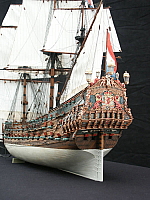7-Provinciën
A question came from the USA (Washington) if we will build a replica on 1:50 scale of the famous Dutch 7 provinciën.
The “Zeven Provinciën” was originally built for the Rotterdam Admiralty, but has become famous as the flagship of Admiral Michiel Adriaenszoon de Ruyter. In marine history ship and admiral have become one.
Michiel Adriaenszoon de Ruyter was born in Vlissingen (Flushing) on 24 March 1607. As so many in those days he went to sea at the early age of eleven. As early as 1633 he sailed as a coxswain and three years later he commanded a private cruiser, equipped to fight the pirates of Dunkerque. In the 1st English war he became a vice-admiral and in the 2nd war Admiral of the Fleet of Holland and West-Friesland, and also Commander-in-Chief of the entire fleet. He managed to assert himself against often supreme enemies and was reputed internationally to be the greatest admiral of his time. At the age of 69 he was wounded in the Battle of Syracuse on 22 April 1676, a naval battle against the French near Sicily. He succumbed to his injuries a week later and his remains were taken back to Holland by a ship called “De Eendracht”. He was buried in Amsterdam in the “Nieuwe Kerk” (New Church).
The “Zeven Provinciën” was an enormous warship equipped with some eighty cannons of various calibres. On the lower deck there were 28 big 36-pounders. On the upper deck a mixture of 26 18/12-pounders. On the higher decks and stern another 26 bronze 6-pounders. The design and construction of the ship were the finest of the period and carried out in many beautiful ornaments and wood carvings. The tableau on the escutcheon is the Coat of Arms of Holland with figures of Justice and Peace. Very impressive, but also the weakest side of the ship. After all a direct hit, concentrated on the escutcheon, would wipe out all vital parts and the batteries of guns from back to front.
The “Zeven Provinciën” saw battle in all English wars. The English fleet operations were aimed at blocking the passage of the Dutch merchant shipping trade. Consequently, keeping the Channel open was of great importance to hundreds of Dutch merchantmen. A well-known encounter during the 2nd English War was the Battle of Dungeness (1652). The 2nd English war was meant to put the English navy out of action. This then happened during the Four Day Sea Battle and the Dutch attempt to do damage to the British reserve fleet in the “Raid on Chatham” (1667). While the French army was invading our country, the last sea battle during the 3rd English War was fought at Kijkduin. This battle ended in a draw, but the English and French enemies did indeed retreat. After this restless period the “Zeven Provinciën” came under the command of a number of captains: Jan van Brakel in 1678, Jan Snellen in 1691 and eventually, Evert de Lieffde. Finally, after 30 years of loyal service, the ship was laid off and sold to be scrapped.
